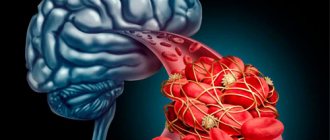Difference between neurosis and psychosis: comparison table
Without going into details, we note that neurosis differs from psychosis in virtually all respects: causes, onset and course of the disease, characteristic symptoms, the patient’s attitude to his condition and, of course, approach to treatment.
For clarity, the main differences are presented in the table:
| Clinical picture and principles of treatment | Neurosis | Psychosis |
| Onset of the disease. | Often occurs immediately after severe stress or trauma. | It begins almost asymptomatically. Determining the exact date of onset of the disease is very difficult. |
| Criticism of the disease. | The person realizes that he is sick and is ready to take measures to solve the problem. | The patient denies having problems and does not want to be treated. |
| Manifestations of the disease. | The characteristic symptoms of neurosis are usually somatoform: increased sweating, rapid heartbeat, fever, chills, or combinations thereof may be observed. | In psychosis, illusions and hallucinations of various types occur. |
| Personality change. | The patient's personality does not change. | The patient's personality undergoes significant changes. |
| Hospitalization. | Not required. The patient is not dangerous to others. | Mandatory requirement. The patient can harm both others and himself. |
| Specialists. | Psychotherapists treat neuroses. | Psychiatrists treat psychosis. |
For those who wish to delve into the issues of the difference between neuroses and psychoses in more detail, the following information will be useful.
Definition of neurosis and its symptoms
A group of disorders that arise in a person due to destructive psychological attitudes and stress is called neurosis. Situations conducive to the development of neurosis:
- hereditary tendency to nervous disorders;
- periodic conflicts at home or at work. Often occur in children and adolescents who grow up in dysfunctional families;
- excessive suspiciousness of the subject. The habit of reacting painfully to minor troubles exhausts the nervous system - a person with low self-esteem and a pessimistic attitude towards life is much more likely to develop neurosis than a positive-minded person;
- physical overload;
- chronic diseases that cause constant discomfort or acute pain (psoriasis, arthritis);
- a strong shock that the subject experienced in the recent past (death of a relative, fire, bankruptcy);
- long stay in a place where he was in danger.
Forms of neurosis:
- neurasthenia;
- fear;
- obsessive states;
- hysteria.
Manifestation of pathology
How the disease manifests itself: the patient’s mood changes sharply, the level of sensitivity increases. You can cry for half a day over a broken plate and be offended for a month at a colleague who did not invite you to his wedding. Self-esteem changes: some patients are overly critical of themselves. Inflated self-esteem is also not uncommon in neurosis.
A person suffers from constant fatigue, although the amount of daily exercise remains the same. A neurotic person is tormented by strong unreasonable fear. The patient experiences increased sweating. Trembling appears in the arms and legs.
The symptoms of a neurotic disorder are noticeable not only to you, but also to your friends and relatives. Can neurosis turn into psychosis: the likelihood of such a development of events is negligible, but an advanced neurotic disorder can undermine the nervous system and lead to insomnia and fainting.
Characteristics of neurosis
Neurosis is not a disease, but a painful condition that combines a whole group of psychogenic disorders and is traditionally considered as a functional disorder of the higher nervous activity of the upper nervous system.
Neurosis does not have an unambiguous definition either in biology or in medicine, but to one degree or another it is familiar to every person. In Russia alone, according to WHO, up to 75% of the population suffers from neurotic disorders, and every year the frightening figure is steadily growing.
Neuroses are dangerous. They can cause a lot of inconvenience, including complete loss of ability to work. But if you consult a specialist in a timely manner and follow the recommendations, they are completely curable. Neurologists and psychotherapists treat disorders of this kind.
The forms of neurosis are quite diverse. Conventionally, they can be divided into two large groups. The first group includes conditions associated with stress: various phobias in which anxiety is provoked by external situations and objects that are not currently dangerous. The second group includes conditions associated with physiological (physical) disorders: anorexia nervosa, bulimia, etc.
Agoraphobia
A term that combines a number of interdependent fears.
For example, fear of leaving the apartment and entering the store. Fear of traveling and being in crowds. The clinical picture of agoraphobia is very diverse. In most cases, symptoms such as dizziness, migraine, lightheadedness or rapid heartbeat are observed. The intensity of anxiety can vary from mild discomfort to panic terror.
Women get sick more often than men. The onset of the disease occurs mainly in adulthood. The main danger is that the patient can completely isolate himself from society, closing himself “within four walls.”
Social phobias
Neuroses that combine fears associated with being in society. Isolated (eg, drinking or eating in public) or diffuse (including most situations outside the family circle). They are often combined with a panicky fear of criticism and low levels of self-esteem. Often accompanied by hand tremors, redness of the skin, the urge to urinate, sudden nausea and vomiting.
Specific phobias
A term that combines fears that are limited to strictly defined circumstances (the sight of blood, being near an object, a thunderstorm, flying on an airplane, being treated by a doctor, etc.). They usually appear in childhood or adolescence and, without proper treatment, persist throughout life. The severity of discomfort resulting from specific phobias depends on how easily the traumatic situation can be avoided.
Paroxysmal anxiety
A group of phobias that are not limited to specific situations. Fears arise suddenly. They have an unpredictable, paroxysmal character.
Typically lasts a few minutes.
Accompanied by chest pain, rapid heartbeat, shortness of breath, a feeling of derealization and depersonalization (loss of the sense of reality of what is happening).
Obsessive-compulsive disorders
Neurosis characterized by repeated actions or thoughts over and over again. Attractions, images or ideas that are almost always aggressive or distressing.
The disorder is typical for both men and women. Appears, as a rule, in adolescence and eventually develops into a chronic form. Often accompanied by depression.
Anorexia nervosa
A disorder characterized by intentional weight loss caused directly by the affected person. It often occurs in teenage girls and young women. The clinical picture is easily recognized: body weight is at least 15% less than expected. The most valuable obsession is the horror of obesity.
Bulimia nervosa
A disorder in which strong food cravings are combined with a morbid fear of obesity. A sick person rushes “from one extreme to another”, tends to abuse laxatives or induce vomiting.
There are other physiological disorders: sexual dysfunctions, sleep disorders, etc. However, in practice, they are usually dealt with by specialists of a narrow profile.
Features of behavior
Patients with OCD exhibit unusual behavior patterns. They are not specific and it is impossible to make a diagnosis based on them, however, experts note that obsessive-compulsive disorder is typical for people with the following traits:
- Responsibility for completing tasks. They strictly follow the rules and regulations, and often invent them for themselves, and then can no longer refuse them.
- Demandingness. This especially applies to managers. They not only follow the rules themselves, but also demand strict adherence to them on the part of their subordinates. The problem is that many people simply consider such orders meaningless and are not ready to tolerate such an attitude towards themselves.
- Superstition. People with OCD are very superstitious and believe in all sorts of omens. Usually the rituals they come up with are associated with superstitions.
Often a person gets bored with rituals, as a result of which he tries to get rid of them. However, anxiety prevents him from doing this. Some people believe that over time everything will go away on its own. However, in most cases the condition worsens and the symptoms of the disorder expand. As a result, it can develop into long-term neurosis.
One of the hallmarks of OCD is treatment resistance.
As you can see, some symptoms, such as voices, visions and intrusive thoughts, resemble signs of schizophrenia, especially pseudoneurotic.
However, they have much more differences. An experienced specialist will never confuse these two disorders. Let's take a closer look at schizoneurosis, or neurosis-like schizophrenia.
Characteristics of psychosis
Psychosis is a serious mental illness that is often not cured, but only corrected by psychiatrists.
Depending on the chronological pattern, manifestations of psychosis are divided into episodic or periodic.
Episodic psychoses
Psychoses characterized by movement disorders, affective disorders and pseudomanic states.
Movement disorders manifest themselves in the form of stupor. Patients freeze in unnatural positions, with wide-open eyes and an expression of suffering on their faces. Stupor may be replaced by increased motor or speech activity. Aggression towards others.
Affective disorders most often manifest as dysphoria. Patients are embittered, withdrawn, tearful, and prone to monotonous lamentations. Less common are fears, depression or euphoria, accompanied by illusory disorders or hallucinations.
Periodic psychoses
Pseudomanic states manifested by senestopathies, rough monotonous pranks, hypochondriacal statements. Visual hallucinations, delusions of jealousy or persecution are possible.
The symptoms of psychosis are extremely broad. A wide variety of disorders may be present in mild or severe forms. Namely:
- Emotional disorders . Distortions of emotional reactivity (quantitative and qualitative changes in emotions), the sensory sphere (progress or regression of feelings) and mood (its decrease or increase). Patients experience higher feelings (personal dignity, aesthetic satisfaction) or, on the contrary, lower ones (arising from instincts or basic needs). They fall into depression and melancholy or experience euphoria and ecstasy. Sharp transitions from one state to another, emotional inadequacy, ambivalence, parapathy or parathymia are possible.
- Disorder of consciousness . Distortion of perception, memory and abstract thinking. Illusions and hallucinations. Patients cannot build logical connections between words, make unexpected conclusions, attach random meaning to certain concepts, and distort phrases without new semantic content. They cannot remember recent events, but they reproduce distant ones in their memory. They become disoriented in time, space and their own personality. Hallucinations are mainly visual: polyopic, hemianoptic, microscopic, autoscopic, Charles Bonnet type. Black and white or color. Extracampal, scene-like and others.
- Psychomotor disorders . Patients speak and move too slowly or too quickly. The transition from hypo to hyperactivity is unpredictable. The quadrigeminal reflex is strengthened.
- Sleep-wake rhythm disorders . Patients experience drowsiness during the day, but have difficulty falling asleep at night. They sleep restlessly and have nightmares at night, which after waking up can turn into hallucinations. In severe cases, inversion of the sleep-wake rhythm or total loss of sleep is possible.
Neuroses differ significantly from psychoses. In addition, the forms of these disorders differ from one another. But occasionally in medical practice we encounter psychoneurosis, which combines the symptoms of two diseases.
Do not self-medicate. Symptoms are often blurred, which complicates the diagnostic process. Only a qualified specialist will help you find peace of mind.
Differences from neurosis
The symptoms of neurotic schizophrenia are similar to those of neurosis. The following criteria allow us to differentiate the diagnosis:
- Neurosis occurs after a strong psycho-emotional shock or as a result of prolonged stress. Schizophrenia can develop for no apparent reason.
- Neurotics are aware of the disease, they understand that they need to seek help. Schizophrenics do not see strangeness in their behavior. As a rule, they are brought to the appointment by relatives.
- Neurosis causes great inconvenience in personal life and at work, but it does not affect the sense of personality. Schizophrenia, even if it is sluggish, leaves an imprint on personal qualities, often leading to their complete collapse.
- Neurosis is successfully treated, and completely. Pseudoneurotic schizophrenia responds well to treatment, but the diagnosis remains forever. A person will have to take medications and engage in prevention throughout his life.
Now let's move on to the specific symptoms of neurosis-like schizophrenia. Some of them are included in the symptoms of OCD.
Differences
OCD differs from schizophrenia in many ways. A doctor will never confuse these two disorders. A common symptom is obsessions and compulsions. However, with neurosis, a person tries to overcome them or at least hide them. A schizophrenic does not do this, because he believes that everything is fine with him.
Neurotics retain common sense. They are aware of their actions, even if they are performed automatically, that is, in the form of compulsions. But at the same time they understand that such a state is not normal. Moreover, they try to behave correctly. Only in severe cases does control disappear completely.
In schizophrenics, mental functions are split. They are not critical of their condition. They may behave provocatively or strangely, but they do not understand that they are causing shock to others. In other words, people with this form of schizophrenia perceive themselves as healthy.
Hallucinations also occur during neurosis, but they are short-term and appear mainly before sleep, when the brain is tired, and after waking up, when brain activity is not as active as during the day. The OCD patient understands that the cause of the hallucinations is his illness.
In schizophrenia, voices and visions are spontaneous, but they can also be chronic. Delusions and hallucinations can transfer a person’s consciousness to another reality.
The main difference between OCD and schizophrenia is that the former does not cause personality damage. A person can completely get rid of the disorder without leaving a trace on his consciousness. Schizophrenia leaves a defect; it affects the person’s “I”. In severe cases, a complete collapse of the personality occurs.
Depressive psychosis, causes
This psychotic state is a phase of a mental illness - bipolar affective disorder.
The opposite status is called manic. Depression as part of this pathology occurs over a longer period and with severe impairments. The outpatient format of therapy is recommended only in the recovery phase or for prevention during remission. Patients require hospital treatment based on the following factors :
- The behavior of sick people is often inappropriate. They can harm their health and be dangerous to others.
- To alleviate the condition and eliminate the manifestations of the disease, potent drugs are used that require constant monitoring of the patient.
- Patients often exhibit suicidal tendencies. Doctors can notice them in a timely manner only with constant monitoring.
Among the reasons leading to pathology, several of the most obvious stand out.
Depressive-psychotic abnormalities are detected against the background of:
- suffering mental trauma;
- development of an intense stressful situation, especially in its chronic course;
- tendency to melancholic experiences, despondency;
- pessimistic mood, excessive “soul-searching”;
- psychasthenic accentuation of personality;
- old age and the presence of serious illnesses;
- undergoing complicated childbirth;
- alcohol, drug and gaming addiction.
These factors can be combined, which significantly increases the possibility of developing pathology.









